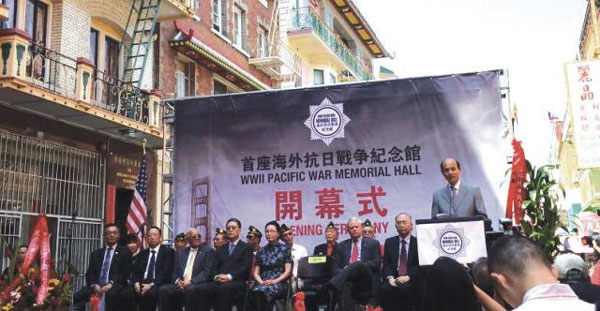'Window' on WWII opens in Bay Area
 |
|
Luo Linquan (standing at right), Chinese consul general in San Francisco, addresses the opening ceremony of the WWII Pacific War Memorial Hall on Aug 15 in San Francisco Chinatown. Florence Fang (fifth from left), curator of the memorial hall, and He Yafei (fourth from left), deputy director of the Overseas Chinese Aff airs Office of the State Council, were among the guests attending the ceremony. CHANG JUN / CHINA DAILY |
The white, three-story building used to house the Chinese Daily Post in 1927, one of the first Chinese newspapers in the United States. During WWII, the building served as a center for overseas Chinese to gather and rally support for their homeland.
Through a 400-day-long effort by organizers, the building has now become the WWII Pacific War Memorial Hall, the first and only one of its kind outside China, as of Aug 15, 2015, the 70th anniversary of the end of WWII and the Chinese People's War of Resistance against Japanese Aggression.
"On Aug 15, 1945, Japan announced its unconditional surrender. Seventy years later, we choose this same date, as the day to have the grand opening of this first Overseas China WWII Pacific War Memorial Hall," said Florence Fang, curator of the memorial hall and a well-known entrepreneur and philanthropist in the San Francisco Bay Area, during the opening ceremony.
"This memorial hall's spirit and goal is to respect history and to cherish peace," she said, "to commemorate all WWII soldiers and civilians, who sacrificed and even gave their lives, fighting for liberty and peace. Without respecting history, there's no justice in the world; without learning from war's lessons, there's no peace in the world."
In the 5,000-square-foot museum are more than 100 artifacts of historic interest and hundreds of historical photos covering the most important aspects of the war, from the pre-Japanese-invasion period from 1931 to 1937 to the Chinese people's resistance on their own terms from 1937 to 1941, the US involvement from 1942 to 1945 and the wartime alliance between the US and China and overseas Chinese people's support.
Among the artifacts are Fang's own collection, loans from China's State Administration of Cultural Heritage and individuals as well as donations from the Flying Tigers Historical Organization and overseas Chinese, said Jia Li, one of the exhibition's planners.
"The audience has a chance to view the exhibits of historic significance, such as the sword of the Class A war criminal and mastermind of the Nanking Massacre, Iwane Matsui, and they also have a chance to experience the touching moments during the cruel war years, like the original copies of a Chinese expeditionary army soldier's note of death in battle and letters from his father," said Li.
"War is cruel, which makes me feel that we are so lucky living in peace time," said Vincent Han, a 12-year-old volunteer guide who is responsible for introducing the exhibition's third chapter on China's Counteroffensives.
Han said he spent two weeks preparing for the introduction and that it was "worth it". "I now have a better understanding of this history myself and I'm glad to be able to help other people better understand it, too," he said.
Christine Qiu was another one of the 14 volunteer guides at the museum. "The war killed 6 million Jews in Europe and more than 100 museums have been set up in the world in memory of them. The number of Chinese people killed by the Japanese army is about six times the Jewish deaths, however, we have just one museum outside China," she said.
"It's necessary for people to learn about the real history so we can cherish the peace we have now," said Qiu, a Silicon Valley engineer.
The museum is not only aimed at telling about the misery and suffering of the Chinese people during the war, but also focused on their fortitude and tenacity in fighting against aggression, and reminding people of the US-China alliance, according to Fang.
The third floor of the museum displays a replica of an Allied military transport aircraft which used to fly "The Hump" over the Himalayas to resupply Chinese war efforts, a parachute used by a Flying tigers' pilot and other exhibits about Americans who traveled to China to fight alongside the Chinese.
The pilot's chute bears witness to the friendship between a US pilot, surnamed Ilnicki, and his Chinese rescuers.
On his way back to Kunming, in Yunnan province, in 1944, Ilnicki's bomber was hit and went down. He parachuted to a village in Hunan province and there he was rescued by local villagers. The pilot chute was then signed by dignitaries and people who helped him after the crash. One of the inscriptions gave an account of the aircraft going down and the pilot parachuting safely to the ground.
"The stories of the Flying Tigers, the Hump and the friendship between the rescued and the rescuers have been passed down from generation to generation," said Luo Linquan, Chinese consul general in San Francisco. "The cross-Pacific alliance between China and the US is an unforgettable part of the world's memory of peace."
Luo said he hoped the museum can serve as a window for overseas Chinese and the American people to learn about this chapter of history, and at the same time demonstrate the Chinese people's achievement in defending national independence, sovereignty and dignity as well as their contribution to the world's anti-fascist war.
liazhu@chinadailyusa.com


















